WATER SCARCITY
Kenya is dependent on rain to fill her reservoirs for basic consumption. There are both economic and physical scarcities; finding a reliable source of clean water is time-consuming and expensive as well as there simply is not enough.
It continues with the cyclic rainfall, poor rainwater harvesting, drought and intense water scarcity (see infograph 1 below). We are unable to remedy the water scarcity and the constant desertification forces that hit parts of northern Kenya.
Poor planning for the drier months, resulting in more of knee-jerk reactions when drought does bite further compounds the situation.
We rely on rainwater to fill our dams for basic consumption as well as a proportion of our electricity generation. In short the water levels go down and the water woes at the tap begin.
Images of lines of Jerry cans, assorted containers, and people going down deeper and deeper into the earth in search of the precious commodity become commonplace. On the other hand the irony of dry taps yet water gushing down to form large pools of stagnant water during the rainy season cannot be missed either.
Water browsers make a killing selling water, often marking up the price upwards of 7 times the original selling price. The situation currently facing Kenya reminds many of 2012 when the water levels in the dams were also very low and it necessitated water rationing and power shedding came soon after. Many Kenyans were at the brink of starvation, as is the situation now.

So what are the solutions?
On a personal level:
1. Do not misuse the water when it does come, I cannot tell you how much it pains to see people misusing water yet right next door they are staring at dry taps.
(2) Using the soapy water from your laundry (when you can do laundry) to scrub high traffic areas on the floors and to flush toilets.
(3) Keep a basin or bowl underneath your vegetables as you wash them, this water can then be used to water the potted plants.
(4) If you can have a shower, as there is actually still water in your tank, have a quick shower and keep a bucket or basin under the shower head. This will collect the water that comes out first. Since it will be warm you can use the water to soak certain items of clothing that have stubborn stains that require warm or hot water to come out. Good examples are egg stains, gum stains and lotion stains.
(5) If your county does not allow rainwater-harvesting push for the legislation of rainwater harvesting. There are many apartment blocks in the city centers that already have the gutters that if allowed could just be connected to large water storage containers.
At the community level we can:
(1) Build more reservoirs in villages and other areas that get heavy seasonal downpours. This does not have to be extremely expensive as many villages already do this by digging deep holes and sandbagging them. If they can afford to do so they will use cement instead to create the perimeter. When it rains the water fills up and covered to reduce evaporation. It is not a long-term solution by any means especially if the rains fail but this blogger is quite sure that the same basic principle can be used and modified slightly to make it a longer-term solution .
(2) Consider desalination and then pump the water to households. Many places such as Israel and U.A.E have used desalination to great success. Yet in Kenya many communities that live in coastal towns particularly face acute water woes.

Above: Infograph 1
(3) Consider recycling the water to some point. In Singapore’s capital city has implemented an extensive system of recycling some of the water from the taps and is pumped back into homes.
images courtesy of :
shutterstock
https://myaquanui.com/2013/10/30/water-scarcity-water-stress-and-the-best-solution/
infograph courtesy of :
https://www.theautomaticearth.com/2014/05/physical-limits-to-food-security-water-and-climate/

Deeply insightful piece and timely for Kenya given the current acute shortage of water. It’s time to reflect on our water management strategies…
LikeLike
Thank you Declan for your kind words. I agree we need to reflect and implement short term and long term strategies and solutions on the ground. We often do not fully implement the strategies and the good ideas stay as good ideas. A good example is the proposal for rainwater harvesting, the idea is great but has it made it past the first reading?
LikeLike
realy nice piece..and i agree this is an issue that needs an urgent audience be it from us(the general public)or even other stakeholders..if this matter were taken into consideration our country wouldn’t be battling drought as is the case today.
LikeLike